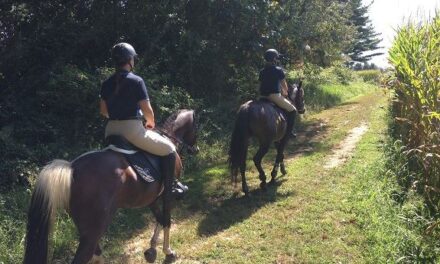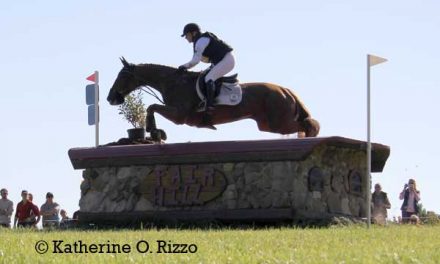first appeared in the May 2018 Equiery
A common question among horse owners in Maryland is whether or not they must be licensed. Often this question is directed towards state stable licenses, which fall under the Maryland Department of Agriculture. Maryland has been licensing stables since 1968, and in 1998 the authority to license and inspect stables was given to the newly established Maryland Horse Industry Board (MHIB). However, in recent months, there have also been many questions surrounding county stable licenses.
At this time, only Montgomery, Prince George’s, and Baltimore Counties require stable licenses, though the definition of a “stable” varies slightly from county to county. Although these definitions might vary, the one common theme among all three counties as well as the state is the welfare of the horses. It is to help ensure the safety and care of the horses that the state and these counties require licenses.
The Purpose
All 23 counties in Maryland offer some sort of animal control or humane society, however, not all these are equipped to deal specifically with equine welfare, which is where the Maryland Horse Industry Board steps in to fill the void. According to the Code of Maryland Regulations for the Department of Agriculture, Title 15, Subtitle 16, Chapter 01, (COMAR 15.16.01.01) the purpose of state stable licensing is to “insure the humane treatment of horses and the safety of horse riders.” State stable licenses are filed through MHIB and must be renewed annually. The one-year licensing period runs from July 1 through June 30 of the following year.
Definition of a Stable
As stated earlier, the definition of a riding stable as it applies to state and county licenses varies.
The State defines a “Horse Establishment” as “an establishment that solicits or offers to the public any of the following services: 1) a boarding stable; 2) a lesson or rental stable; or 3) a rescue or sanctuary stable” (Authority: Agriculture Article, §§2-701, Annotated Code of Maryland). MHIB further explains this on its website under “General Regulations-Licensing Period & Civil Penalty System” as applying to any stable that solicits the general pubic, has one or more horses and either gives lessons, boards horses or provides rentals. In addition, rescue or sanctuary stables must be licensed by the state. (http://mda.maryland.gov/horseboard/Pages/regulations.aspx)
However, the state has a few exemptions to the definition. Thoroughbred and Standardbred racing stables are exempt from state licenses, as are farms that use horses for agricultural purposes, such as working or cultivating soil or herding livestock.
Montgomery County defines an “Equestrian Facility” as “Any structure or land that is used primarily for the care, breeding, boarding, rental, riding, or training of horses or the teaching of equestrian skills.” Montgomery County also includes facilities that hold events such as “competitions, exhibition, or other displays of equestrian skills.” (Montgomery County Code, Chapter 59-3.2.4A)
Baltimore County uses the term “Commercial Stable” when defining stables that need a county stable license. However, “Commercial Stable” is defined as “a facility that, with or without charge, provides: riding instruction on horses, ponies, donkeys, mules or burros, or boarding for horses, ponies, donkeys, mules or burros.” Baltimore County also includes facilities that offer horses, ponies, donkeys, mules or burros “for hire” under the definition of Commercial Stable, and any facility that is “engaged in the business of buying, selling or trading horses, ponies, donkeys, mules or burros.” (Baltimore County Code of Ordinances, Article 12, Title 1, Subtitle 1, 12-1-101)
In Prince George’s County, a stable is referred to as a “Riding School or Stable” and defines these as “any place at which horses are boarded or displayed; or which has horses available for hire or riding instruction or pony rides; or which regularly buys, sells, trains, or trades horses, ponies, donkeys, mules, or burros, including any Thoroughbred racetrack, trotting track, or rodeo.” (Prince George’s County Code of Ordinances, Section 3, Division 1.70).
The fees for licenses also vary, with the State charging $125, Montgomery County charging $50, and Baltimore County charging $190. Prince George’s County’s fees depend on the number of horses–if fewer than 10, it is $50, between 10 and 20 horses it is $100, and over 20 horses it is $150.
Standards of Care
The primary stated purpose of stable licenses is to ensure the quality of care of horses, but there is not one common set of Standard of Care guidelines adopted by state and county agencies. However, under Maryland’s Criminal Code, Title 10, Subtitle 604, any person having the charge or custody of an animal must provide “(i) nutritious food in sufficient quantity, (ii) necessary veterinary care, (iii) proper drink, (iv) proper air, (v) proper space, (vi) proper shelter; or (vii) protection from the weather.”
The Maryland Horse Council has created a “Guide to Minimum Standards of Care for Equines” that interprets and fleshes out these statutory standards of care. This Horse Council document has been used extensively in Maryland courts as well as in courts in other states in adjudicating equine cruelty and neglect cases. It is also used as a reference document by animal control and humane society personnel.
MHIB lists equine specific standards of care under COMAR 15.16.01.07 Licensing Requirements, which include all of the above as well as some additions, such as preventing excessive manure accumulation and the control of flies and rodents. There are also general requirements related to fencing used to confine horses, maintaining clean stalls, and making sure that stable tools are properly stored when not in use. In addition, MHIB has a section of Special Requirements related to boarding, rescue/sanctuary and lesson/rental classifications, in particular with regard to the use, handling and equipment of lesson and rental horses.
In Baltimore County, Commercial Stables fall under the “holding facility” regulations and must comply with the minimum standards found in Section 12-6-103. These standards are quite similar to the State, though are geared towards all types of animals.
Prince Geroge’s County has a separate section specifically for standards for riding schools and stables under Section 3-173. Some of its requirements are more specific, such as stating that proper shelter is “an enclosure with at least three solid walls and a solid roof.” It also specifies, “stacked manure piles shall not be allowed to stand for a period in excess of four days except when conditions of ice and/or snow prohibit its removal.”
Montgomery County seems to have the largest list of standards, found under 05.404.01.03. These licensing requirements include items such as “a certificate from a doctor of veterinary medicine stating that each individual horse or pony available for hire is physically sound for riding purposes” as well as certifications from the Fire Marshall and Health Officer. The standards of care for horses and ponies is similar to the State and other two counties, and are listed under “Special provisions for horses and ponies.”
Stable Inspections
Once you have determined if you need a state and/or county license, have turned in your application and paid your fees, you have consented to have your facility inspected.
At the state level, these inspections are done by State Stable Inspectors under MDA and MHIB. MHIB has been conducting stable inspections since 1998.
State Stable Inspectors Ellen James and Pegeen Morgan, who both have long histories within the equestrian world, divide up the state, inspecting the state’s over 800 licensed stables. They use a standardized Inspection Report form to evaluate the facility based on each section of the general and special requirements for stables. Each line item is given a score from 1 to 4: 1 being “compliance,” 2 “needs improvement,” 3 “non-compliance” and 4 “not applicable.” There is also room on the form for comments and recommendations.
If a stable fails to pass the initial inspection, the facility may not be issued a license. If a facility that has already passed an inspection and is licensed later fails a subsequent inspection, the facility is given sufficient time to correct the deficiencies before being re-inspected. Formal charges against the licensee are only filed if a facility does not pass after a third inspection. State law provides for both civil and criminal penalties for failure to comply with the licensing requirements.
At the county level, members of Animal Control, which falls under the Department of Police, often do inspections under the county licensing rules.
Licensing Benefits
A stable license demonstrates to clients and potential clients that the stable is a bona fide, responsible equine establishment abiding by regulations issued by the State or County that are protecting the welfare of the horse as well as the safety of the rider. In a competitive business world, this seal of approval helps the business in many ways. Similar to a good Better Business Bureau rating, a stable license signals to clients and potential clients that a business follows industry-wide standards for care and safety of people, horses, equipment and facilities.
On the State level, MHIB has a print and online guide to licensed stables in Maryland. If you are not licensed, you are not on this public list! In addition, State licensed stables are eligible to become certified Horse Discovery Centers through MHIB. MHIB has an ambitious and active program to market and promote certified Horse Discovery Centers to the public.
State licensed stables are also eligible for local, state and federal cost-sharing programs. They can also apply for annual grants through MHIB.












